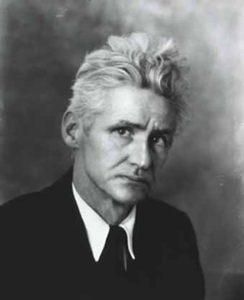
Biography
John Edward Costigan was born in Providence, RI in 1888. His parents died in 1900, and John was taken in by his aunt and uncle, the vaudeville performers Helen and Jeremiah Cohan. That name may sound familiar, since their son was the songwriter, actor and producer George M. Cohan, now memorialized with a statue in Times Square. He was ten years John's senior and had already written one of his many musicals, which would earn him the title of the "father of the American musical comedy."
John was hardly so high-flying. He worked first as an errand boy and then in local costume jewelry factories. In 1903 he moved to New York, where his uncle helped him get a job with the H.C. Miner Lithographing Company. He started as a pressroom helper but gradually worked his way up in the company. In 1906 Costigan spent a few weeks taking classes at the Art Students League, encountering major artists such as William Merritt Chase and George Bridgman. But his main education in art came from hanging out at the Kit Kat Club, where illustrators and newspaper artists would gather to sketch live models.
In 1912 Costigan became a sketch artist for H.C. Miner, a position he held until the company's demise in 1934. By night he would attend rehearsals of his cousin's new plays, while working on posters for these and similar entertainments during the day. He was married briefly in 1913-1914. But his art career was beginning to take off. He exhibited at the MacDowell Club in New York in 1915, at the Corcoran Gallery in Washington in 1916, and at the Babcock Gallery in New York in 1917.
Costigan enlisted in the army from 1918-1919, seeing action with the 52nd "Pioneer" Infantry Division. In 1919 he married the scuptor and professional artist's model Ida Blessin, with whom he was to have two sons and three daughters. The couple moved to Orangeburg, NY, along the Hudson River 25 miles outside of New York City. He remained there the rest of his life, concentrating his artwork on the bucolic surroundings of that area.
Recognition of Costigan's talent came rapidly in the 1920s. He received an award from the National Academy of Design in 1920, and he was awarded the purchase prize of the Art Institute of Chicago in 1922. His first solo show was at the Frank K.M. Regn Gallery in New York in 1924, and he was elected a full Academician of the National Academy of Design in 1928.
The Depression forced the closure of the H.C. Miner Company in 1934, and Costigan joined the Public Works of Art Project. His work was the subject of a one-man show put on by the Smithsonian Institute in 1937. He taught briefly at the Art Students League and took students at his studio in Orangeburg.
During World War II (1942) Costigan worked as a machine operator on the night shift at a defense plant, continuing to do his artwork by day. His work was exhibited at the Whitney Museum of American Art in 1944 and at the Carnegie Institute of Pittsburgh in 1944-1946. From 1945-1950 he received steady income illustrating McCall's Bluebook magazine.
In 1968 the Smithsonian sponsored a retrospective of Costigan's work. He was then 80 years old but continuing to paint. The exhibit debuted at the Paine Art Center and Arboretum in Oshkosh, WI and ciculated nationally. Costigan died in Nyack, NY in 1972.


Critical Analysis
Descriptions of the Kit Kat Club make it clear that the place provided an education for its patrons. But for most it was an education in revelry and the joie de vivre of the art world. For Costigan it was where he received the bulk of his education in art. That is to say, he was almost entirely self-taught, his consumate skills in drawing and composition honed by years of practice and self-discipline. Actually, Costigan probably got a significant portion of his art education at the Metropolitan Museum of Art and other New York museums, not just at the Club.
It's interesting that with such a bohemian start to his art career, Costigan did not gravitate to the Ashcan School of painting. Rather, after moving out of the city with his second wife, he focused on bucolic landscapes of upstate New York. His subject matter - and perhaps his style - earned him the label of "America's Millet." Costigan's paintings certainly emphasized the rural landscape in the manner of Millet. And his brushwork characterized American Impressionism. His paintings radiated a degree of luminescence from this brushwork, showing a dazzling display of light from the natural environment and in the figures he displayed.
Costigan's drawings are also similar to those of Millet. But Costigan's compositions are slightly more complex than those of Millet. They are executed with an eye toward landscape and the way in which people and animals interact with this landscape. Thus Costigan was a painter of the landscape and the things living within it.
Murals
- Rensselaer, Indiana - Post Office: Receiving the Mail on the Farm
- Stuart, Virginia - Post Office: Receiving Mail on the Farm
References
- John Costigan (Caldwell Gallery). By Zenobia Grant Wingate.
- John Edward Costigan (askART).
- John Edward Costigan (Los Angeles County Museum of Art).
- Kit-Kat Club Exhibit: Paintings and Sketches Seen Through a Haze of Smoke, New York Times February 7 (1904).
- Landscape with Figures (Los Angeles County Museum of Art).